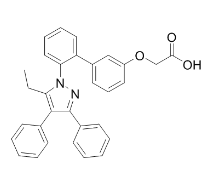All AbMole products are for research use only, cannot be used for human consumption.

In vitro: BMS-309403 binds to FABP4 with high affinity and shows over 100-fold selectivity against FABP5 as well as the heart isoform FABP3. BMS-309403 interacts with the fatty-acid-binding pocket within the interior of the protein and competitively inhibits the binding of endogenous fatty acids. Treatment with BMS-309403 significantly decreased MCP-1 production from THP-1 macrophages in a dose- and time-dependent manner. BMS-309403 stimulates glucose uptake in C2C12 myotubes in a temporal and dose dependent manner via activation of AMP-activated protein kinase (AMPK) signaling pathway but independent of FABPs.
In vivo: A 6 week treatment with BMS-309403 improves endothelial function, phosphorylated and total eNOS and reduced plasma triglyceride levels but does not affect endothelium-independent relaxations. In cultured human microvascular endothelial cells, lipid-induced A-FABP expression is associated with reduced phosphorylated eNOS and NO production and is reversed by BMS-309403. The extent of atherosclerotic lesion area in the proximal aorta is significantly reduced in the BMS-309403-treated group compared with vehicle-treated controls in both the early and late intervention studies.
| Cell Experiment | |
|---|---|
| Cell lines | IL-4-stimulated cells |
| Preparation method | LPL expression correlated with increased very low density lipoprotein (VLDL)- induced triglyceride accumulation in IL-4-polarized macrophages, which was sensitive to inhibition of lipolysis or PPARg antagonism. Inhibition of FABP4 during differentiation using chemical inhibitors BMS309403 and HTS01037 or FABP4 siRNA decreased the expression of FABP4 and LPL, and reduced lipid accumulation in macrophages treated with VLDL. |
| Concentrations | 50 mM |
| Incubation time | 6 h |
| Animal Experiment | |
|---|---|
| Animal models | C57BL/6J male mice |
| Formulation | PBS |
| Dosages | 15 mg/kg/day |
| Administration | i.v. |
| Molecular Weight | 474.55 |
| Formula | C31H26N2O3 |
| CAS Number | 300657-03-8 |
| Solubility (25°C) | 62.5 mg/mL in DMSO |
| Storage |
Powder -20°C 3 years ; 4°C 2 years In solvent -80°C 6 months ; -20°C 1 month |
| Related Products |
|---|
| Myoglobin (from equine skeletal muscle)
Myoglobin is a small molecular pigment protein formed by binding globin to Heme, which can be reversibly bound to oxygen to form MbO2, MbO2 is called oxymyoglobin, and Mb is called deoxymyoglobin. Myoglobin has the role of transporting and storing oxygen in muscle cells. |
| Hemoglobin (from bovine blood)
Hemoglobin is a iron-containing protein in red blood cells with oxygen binding properties. Hemoglobin is an inducer of HO-1. Hemoglobin consits of heme, which binds to oxygen. Hemoglobin also transports other gases, such as carbon dioxide, nitric oxide, hydrogen sulfide and sulfide. |
| Diethylenetriaminepentaacetic dianhydride
Diethylenetriaminepentaacetic dianhydride (DTPA anhydride) is a bifunctional chelator whose anhydride can react with amino groups in proteins (such as lysine residues) to form stable amide bonds. Diethylenetriaminepentaacetic dianhydride (DTPA anhydride) can also bind to radionuclides to synthesize radionuclide-labeled drug conjugates (RDCs). |
| 3-Phenylthiophene
3-Phenylthiophene is a biochemical material that can be used in scientific research. 3-Phenylthiophene is a conducting polymer precursor. |
| DSPE-PEG-FA
DSPE-PEG2K-FA is a PEG derivative containing folic acid. DSPE-PEG2K-FA has a targeting effect and can bind to folic acid receptors in cancer cells. DSPE-PEG2K-FA forms micelles/lipid bilayers and can be used in research on targeted drug delivery systems. |
All AbMole products are for research use only, cannot be used for human consumption or veterinary use. We do not provide products or services to individuals. Please comply with the intended use and do not use AbMole products for any other purpose.


Products are for research use only. Not for human use. We do not sell to patients.
© Copyright 2010-2024 AbMole BioScience. All Rights Reserved.
